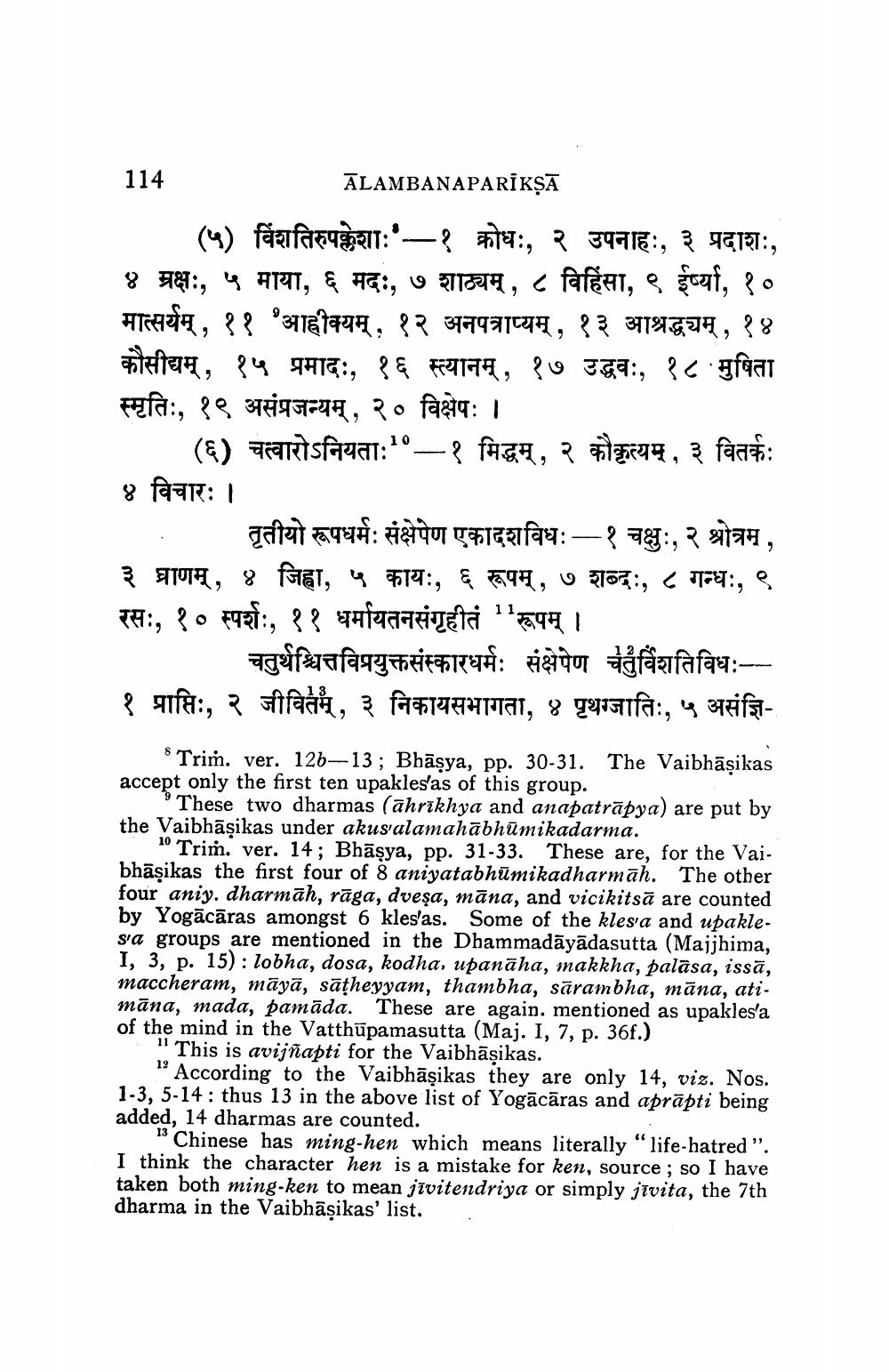________________
114
ĀLAMBANAPARĪKŅĀ
(५) विंशतिरुपक्लेशाः'-१ क्रोधः, २ उपनाहः, ३ प्रदाशः, ४ प्रक्षः, ५ माया, ६ मदः, ७ शाठ्यम् , ८ विहिंसा, ९ ईर्ष्या, १० मात्सर्यम् , ११ °आहीक्यम् , १२ अनपत्राप्यम् , १३ आश्रद्धयम् , १४ कौसीद्यम् , १५ प्रमादः, १६ स्त्यानम् , १७ उद्धवः, १८ ‘मुषिता स्मृतिः, १९ असंप्रजन्यम् , २० विक्षेपः ।
(६) चत्वारोऽनियताः' - १ मिद्धम् , २ कौकृत्यम् , ३ वितर्कः ४ विचारः ।
___तृतीयो रूपधर्मः संक्षेपेण एकादशविधः - १ चक्षुः, २ श्रोत्रम् , ३ घ्राणम् , ४ जिह्वा, ५ कायः, ६ रूपम् , ७ शब्दः, ८ गन्धः, ९ रसः, १० स्पर्शः, ११ धर्मायतनसंगृहीतं 'रूपम् ।
__चतुर्थश्चित्तविप्रयुक्तसंस्कारधर्मः संक्षेपेण चतुर्विंशतिविधः-- १ प्राप्तिः, २ जीवितम् , ३ निकायसभागता, ४ पृथग्जातिः, ५ असंज्ञि
Trim. ver. 12b-13; Bhāsya, pp. 30-31. The Vaibhasikas accept only the first ten upakleslas of this group.
These two dharmas (ahrīkhya and anapatrāpya) are put by the Vaibhāşikas under akus alamahābhūmikadarma.
10 Trim. ver. 14; Bhāsya, pp. 31-33. These are, for the Vaibhāsikas the first four of 8 aniyatabhūmikadharmāh. The other four aniy. dharmāh, rāga, dveşa, māna, and vicikitsā are counted by Yogācāras amongst 6 klesas. Some of the klesa and upaklesa groups are mentioned in the Dhammadāyādasutta (Majjhima, I, 3, p. 15): lobha, dosa, kodha, upanāha, makkha, palāsa, issā, maccheram, māyā, sāțheyyam, thambha, sārambha, māna, atimāna, mada, pamāda. These are again. mentioned as upakles'a of the mind in the Vatthūpamasutta (Maj. I, 7, p. 36f.)
"This is avijñapti for the Vaibhāşikas.
" According to the Vaibhasikas they are only 14, vis. Nos. 1-3, 5-14 : thus 13 in the above list of Yogācāras and aprāpti being added, 14 dharmas are counted.
13 Chinese has ming-hen which means literally "life-hatred ". I think the character hen is a mistake for ken, source ; so I have taken both ming-ken to mean jīvitendriya or simply jīvita, the 7th dharma in the Vaibhasikas' list.




